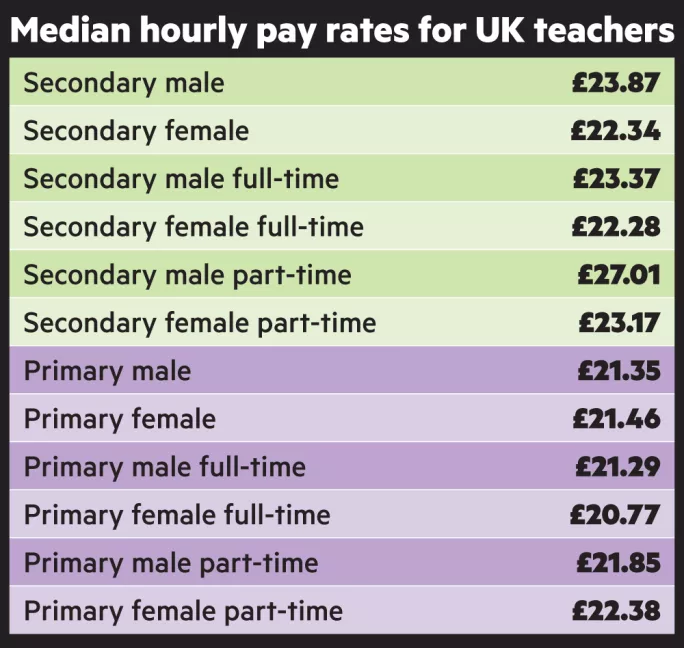Female teachers are ‘denied thousands’, pay data shows

Female teachers working in secondary schools are earning on average 6.4 per cent less than their male colleagues, new government figures reveal. However, in primary and nursery education, female teachers are paid on average 0.5 per cent more than men.
Justine Greening, who holds the ministerial brief for women and equalities as well as being education secretary, has launched a new online tool showing the gender pay gap in different occupations.
The figures have been calculated by the Office for National Statistics (ONS) using median hourly pay rates, excluding overtime, and relate to teachers across the UK. They do not include headteachers but do include deputy and assistant heads. Women teaching in secondaries earn on average £22.34 per hour compared with the £23.87 received by their male colleagues - a 6.4 per cent difference. The gap is slightly smaller for those working full-time in secondaries, at 4.7 per cent, and much larger for those working part-time, at 14.2 per cent.
‘Failure of employers’
Chris Keates, general secretary of the NASUWT teaching union, said: “The cost of the gender pay gap equates to female teachers being denied thousands of pounds each year in lost income. Gender inequality also signals the failure of employers to recognise and value the potential of all teachers in meeting the needs of children and young people.”
But the picture is different in primary and nursery education, where on average women are paid 0.5 per cent more, receiving £21.46 per hour, compared with the £21.35 per hour received by men.
However, there is a big difference between those employed full- and part-time.
Part-time primary female teachers are paid 2.4 per cent more than their male counterparts, but women working full-time are paid 2.5 per cent less.
The figures also reveal a 3.3 per cent pay gap among teaching assistants - across primary and secondary - with women receiving on average £8.88 per hour compared with the £9.19 per hour earned by men.

For full-time teachers of pupils with special educational needs and disabilities (SEND), women are paid 0.2 per cent less than men, and those working part-time are paid 4.8 per cent less. However, taking the SEND profession as a whole, female teachers are paid 3.5 per cent more.
The ONS said that this was because, alongside the gender pay gap for SEND teachers, there was another pay gap related to full-time staff, who earned less per hour on average than their part-time counterparts.
Because the majority of male SEND teachers are full-time, and 72 per cent of higher-paid SEND teachers who work part-time are female, this cancels out the gender gap.
The figures do not show the difference in rates of pay between women and men doing the same job, but rather an average of what people are earning across an occupation.
Malcolm Trobe, interim general secretary of the Association of School and College Leaders, said that the data for teachers reflected “quite a complex situation”.
He suggested that the gap in secondary schools could be linked to teaching and learning responsibility (TLR) payments and the higher number of female part-time teachers.
“With the part-time [teachers] it will be often female returners, who often may well then not be holding TLRs,” he said.
Positions of responsibility
Mr Trobe said that the pay gap in teaching was probably smaller than for the economy as a whole because of national pay and conditions. “The same job generates the same pay in teaching,” he added. “It’s not as if we have got what you occasionally will see in industry and business - that element of discretion as to what people are paid.”
Ms Greening said: “To help women to reach their potential and eliminate the gender pay gap, we need to shine a light on our workplaces to see where there is more to do.”
Ms Keates added: “The government is finally waking up to the stark facts of gender pay inequality, and that is an important first step.
“But the government now needs to show its determination to take action to end gender inequality and sex discrimination in the workplace and to ensure that all schools take these issues seriously.”
You need a Tes subscription to read this article
Subscribe now to read this article and get other subscriber-only content:
- Unlimited access to all Tes magazine content
- Exclusive subscriber-only stories
- Award-winning email newsletters
Already a subscriber? Log in
You need a subscription to read this article
Subscribe now to read this article and get other subscriber-only content, including:
- Unlimited access to all Tes magazine content
- Exclusive subscriber-only stories
- Award-winning email newsletters